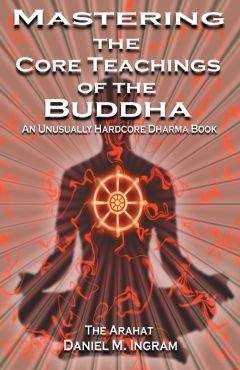Daniel Ingram - Mastering the Core Teachings of Buddha - An Unusually Hardcore Dharma Book
На сайте mybooks.club вы можете бесплатно читать книги онлайн без регистрации, включая Daniel Ingram - Mastering the Core Teachings of Buddha - An Unusually Hardcore Dharma Book. Жанр: Прочее издательство -,. Доступна полная версия книги с кратким содержанием для предварительного ознакомления, аннотацией (предисловием), рецензиями от других читателей и их экспертным мнением.
Кроме того, на сайте mybooks.club вы найдете множество новинок, которые стоит прочитать.

Daniel Ingram - Mastering the Core Teachings of Buddha - An Unusually Hardcore Dharma Book краткое содержание
Mastering the Core Teachings of Buddha - An Unusually Hardcore Dharma Book читать онлайн бесплатно
The Progress of Insight
closely. At some point, Fruition will no longer be as attractive and one will feel that one really could be practicing more clearly and precisely.
This is a strong sign that the next set of stages is ready to arise.
That said, there may be times when one simply doesn’t want to make progress as one can’t afford to be risking another Dark Night at that point in their life. Strong resolutions to stay in Review, a lack of really precise investigation and lots of indulgence in concentration states can help one stay in a Review phase until one is ready to move onward.
However, progress of some kind can only be postponed for so long, and the dharma has a relentless way of pushing us onward.
216
Mastering the Core Teachings of the Buddha
25.THE VIPASSANA JHANAS
The vipassana jhanas are a way of describing the stages of insight that is a bit more broad than the map that breaks the stages down into 16 ñanas. They are two descriptions of the same territory, and both have their uses. The vipassana jhanas differ from the concentration jhanas (samatha jhanas) in that they include the perception of the Three Characteristics, rather than the “pure” samatha jhanas that require ignoring the Three Characteristics to get them to appear stable and clean. However, the two may share many qualities, including very similar widths of attention and other aspects. There are eight vipassana jhanas, the first four that are formed, and the last four that are formless, with the odd exception of the fact that the eighth vipassana jhana (Neither Perception Nor Yet Non-Perception) cannot be easily investigated, as it is generally too subtle to clearly reveal the Three Characteristics. Thus, calling it a vipassana jhana is a bit problematic.
However, it is part of the standard pattern of progress, so is worthy of inclusion, and helps explain some of the material found in the old texts.
Remember how I mentioned in the chapter called Concentration vs.
Insight that the original texts used the same four or eight jhanas to delineate the states of concentration and the stages of insight?
Remember how I said that the delineation of the stages of insight didn't occur until the later commentaries? In the second half of the 20th Century, considerable work was done to try to resolve these maps. As with most terminological issues in the spiritual life, there is some disagreement about just how the jhanas and the stages of insight line up, and I will touch on these in this chapter.
The practical application of delineating the vipassana jhanas is that the traps that awaited us in the samatha jhanas can arise during the progress of insight, and so being able to apply the body of advice that deals with these occurrences can be very helpful. For instance, we may be going along in the progress of insight but get stuck when we stop investigating rapture, which is a part of the early jhanas and also of some of the early insight stages. Thus, realizing that there are some relationships between the samatha and vipassana jhanas can keep us on the lookout for aspects of our experience that we may be missing or
The Vipassana Jhanas
artificially solidifying, as it is so tempting to do so. Going the other way, if we have some mastery of a set of insight stages, we can use these stages to learn get into samatha jhanas by concentrating on solidifying their predominant positive qualities.
There are also those who say that the jhanas and stages of insight do not line up at all, but this is too doctrinal, not in accord with what one experiences on the cushion (or in some other posture), and doesn't help resolve the problems created in the original texts of the Pali Canon. For those who are still die hard traditionalists and believe that the jhana terminology only applies to pure concentration practices, I offer the following quote from the Buddha that is found in my favorite sutta,
#111, One by One as They Occurred, in The Middle Length
Discourses of the Buddha, as translated by Bhikkhu Ñanamoli and Bhikkhu Bodhi:
“And the states in the first jhana – the applied thought, the sustained thought, the rapture, the pleasure, and the unification of mind; the contact, feeling, perception, volition, and mind; the zeal, decision, energy, mindfulness, equanimity and attention – these states were defined by him one by one as they occurred; known to him they arose, known to him they were present, known to him they disappeared. He understood thus: ‘So indeed, these states, not having been, come into being; having been, they vanish.’”
Those with traditional views can squirm and pontificate any way they like, but this guy is clearly maintaining an extremely fast, consistent and precise investigation of impermanence and is thus clearly doing insight practices.
To digress for just a moment into another rant, the guy the Buddha is talking about here is none other than my hero, Sariputta, who incidentally is often the whipping boy of much ridiculous and degrading Mahayana propaganda. Don’t get me wrong, the Mahayana has done some great things in its day, but ragging on someone with this level of skill and insight is just hypocritical and arrogant beyond reason. The Buddha says that Sariputta goes on to do very precise and powerful insight practices high up into the formless realms and attains to very liberating insights. I often hear Nouveau Tibetan Buddhists making comments that clearly indicate that they feel themselves to be quite 218
The Vipassana Jhanas
qualified to denigrate his practice and don’t seem to notice how ironic this is, as they are almost always those whose own spiritual progress doesn’t qualify them to lick the muddy sandals of someone with a fraction of Sariputta’s talents. When one in a thousand of the meditators I meet who make these absurd and insulting statements about Sariputta can do what he could do or understand what he understood, I’ll eat this book. You have no idea how good it feels to write paragraphs like this one.
Back to business. All of this map stuff is only helpful if it keeps you practicing clearly and in a way that brings results. I will discuss more of the pros and cons of maps soon enough.
BILL HAMILTON’S MODEL
The vipassana jhana model I like the most because it is the one that most clearly fits with my extensive investigation of the vipassana jhanas is the one that was used by the late, great Bill Hamilton. He was also quite a mighty meditator in his own right, if a highly under-appreciated one.
True, he was a quirky old bat on a good day, but he also died an arahat and a mighty scholar who had complete mastery of the formless realms.
There was nothing particularly spectacular about Bill’s life other than his understanding of it, and he died in poverty and obscurity in basic denial of the severity of his pancreatic cancer. I have never met anyone who had given the question of the vipassana jhanas more consideration, and his fascination with complex models was remarkable. A quick digression here about Bill, as I did dedicate this book to his memory...
Bill Hamilton was not only a meditation master, he was also a rogue teacher and basically felt like an outcast from the modern international Vipassana community. The guy was basically too smart, too
uncompromising, too scholarly, and too dedicated to non-watered-down dharma and to absolute mastery to be a popular mainstream teacher.
He didn’t teach to make people feel good about themselves, with friends, or attain to power, fame or money.
His obscurity was a tragic loss for the many people who didn't know about him. However, for me and a few others who knew about him and were willing to put up with the fact that he was basically a strange, suspicious, perhaps paranoid, and fairly quirky dude, Bill Hamilton was just what we were looking for.
219
The Vipassana Jhanas
Bill seemed to live for the sole purpose of sharing his dharma rather than for flying around the world, making money, or being popular.
Unlike the few other Western dharma teachers with his level of mastery, you could call Bill on the phone and talk for hours about this stuff, and then you could do it again. His very unpopularity made him a true and accessible teacher. The other nice things about Bill were that he would talk about actual mastery (though you had to drag it out of him) and also had incredibly high standards that I found quite refreshing.
Bill also taught in a very interesting way. His style was basically to seem extremely skeptical that any of your descriptions of any experiences could really have anything to do with the attainment of anything. This was basically quite irritating, but it made his students question deeply whether or not they were really experiencing what they thought they were and so look more deeply at the truth of each moment. It also served as a helpful counterbalance to his interest in models and specifically named levels of attainment. His teaching style didn't win him many friends, but it was powerful and served his ends.
Part of my fantasy is that a bit of his edge, uncompromising attitude and deep understanding may have come through in this work, though it must be stated explicitly that Bill never let on that he was particularly impressed with anything I ever described in my own practice.
Back to discussing Bill's Vipassana Jhana model. The table below explains which ñanas fall into which jhanas, and is a re-arrangement of the table in the beginning of the chapter on the Progress of Insight: Vipa ssa na Jhana Ñanas
First
1-3: Mind and Body, Cause and Effect, Three
Characteristics
Second
4: The Arising and Passing Away
Third
5-10: The Dark Night
Fourth-Eighth
11-14: Equanimity, Conformity, Change of Lineage,
Path
Thus, when in each of those ñanas, one can learn something from its jhana aspect, and when in each of the jhanas one can notice what insight territory is available there. Further, as the division between 220
The Vipassana Jhanas
samatha and vipassana is actually not nearly so straightforward as some would make it out to be, there can be a lot of natural movement back and forth that can occur between vipassana jhanas and samatha jhanas even when trying to keep to just one side. As the Three Characteristics are always presenting themselves, even in seemingly created, blissful, stable samatha territory, those with strong mindfulness and
concentration may have to work to avoid perceiving them. Also, those doing strong insight practice may again and again chance into territory that has a more samatha feel, and if they are expecting things to be purely by the ñana descriptions they may get lost or confused by this.
Lastly, those who have attained at least stream entry are constantly cycling through the ñanas from the 4th to the 11th and then to Fruition, so even if they try to do pure samatha practice, the pull towards each next ñana/vipassana jhana is strong, and they basically are always from then on doing some fusion of the two even when they try to keep things purely on the samatha side.
I will illustrate the vipassana jhanas with a description of some candle-flame meditation I did when on retreat and playing around with the samatha jhanas by using kasinas. Kasinas are various traditional practices that involve using physical objects such as colored disks, candles, etc. as a starting point to attain samatha jhanas, powers and the like. They are described in the standard references I list in the chapter on the the Concentration States.
The retreat when I first really nailed down the details of the vipassana jhanas was a 17 day retreat that I went on when I was an anagami (the third stage of awakening in one of the models of awakening, to be discussed shortly). I didn't begin playing with this territory until around the second week of the retreat, and by that point my concentration was very strong and flexible. It didn't take me more than a day before I could go through the following cycle. Initially, I would stare at a candle flame until I really could stay with it, then there would be a natural shift, I would close my eyes, and I would see the visual purple phenomena where the afterimage of the flame was burned onto my retina.
This would fade in a few seconds to be replaced by a red dot in the center of my visual field. The red dot was clear, very round, pure, bright 221
The Vipassana Jhanas
and seemingly stable. However, within a minute or so it would begin to shake, roll off to one side, and I would notice all sorts of things about how intention and observation messed with the position, stability, and clarity of the dot. First seeing the dot is the first samatha jhana, and in this case is the equivalent of Mind and Body, where mental phenomena become clear external objects. Noticing things about intention influencing the position and stability of the dot is cause and effect.
Shortly thereafter this would become irritating and the dot would begin to shake, shudder, split up, spin off to one side or the other, and generally seem to misbehave quite on its own. This was the entrance to the Three Characteristics. After a while of this, practice would shift, become naturally stronger, and this slightly larger red dot would appear in the center again that stayed there on largely its own, but it had a gold spinning star in its center that would spin on its own with a speed and direction that varied with the phase of the breath, which I noticed when I would break my focus enough to notice that. This addition of motion, the image happening on its own, and somewhat wider attention (wider dot), not to mention bliss when I broke my concentration a bit and focused on my body, is the entrance to the second vipassana jhana.
The red dot with the spinning gold star would gradually acquire purple, green and blue rings around its outside, and then there would be a sudden shift where the red dot would vanish and be replaced by a slightly larger black dot. The black dot initially would seem to be a good focus, but quickly the area around the black dot got more interesting, with many very complex multi-point stars all circling slowly around it, getting wider and wider, with the interference patterns between them getting more and more complex, while the black dot faded somewhat, but to what was unclear. This addition of a problem perceiving the center but with complex patterns of experience with multiple frequencies going out to the periphery marks the early and middle phases of the third vipassana jhana. Further, as the thing got wider, there was this slightly disconcerting feeling that attention was out of phase with the visuals.
As the complex patterns around the outside began to become more spherical as the edges wrapped around towards me, they began to be made out of lines that had more of a rainbow quality to them, with 222
The Vipassana Jhanas
many complex motions and many-fold symmetry. This was harder to pay attention to and simultaneously comprehend it all, marking the mature third vipassana jhana and the later stages of the Dark Night.
Note, as this is being done with almost no fixation on psychological content and with very strong concentration, I did not have any of the typical feelings that sometimes accompany this territory when it cycles through with less concentration. Instead, it stayed at the level of geometry, image and light except when I widened my attention somewhat to notice other aspects.
This complex sphere on which was unfolding more and more
Похожие книги на "Mastering the Core Teachings of Buddha - An Unusually Hardcore Dharma Book", Daniel Ingram
Daniel Ingram читать все книги автора по порядку
Daniel Ingram - все книги автора в одном месте читать по порядку полные версии на сайте онлайн библиотеки mybooks.club.




